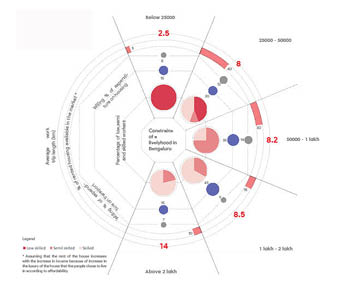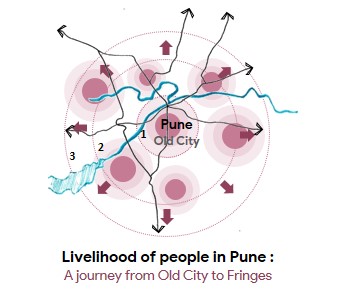FOUNDATION PROGRAM
- Faculty Foundation Program
Housing, Jobs & Transport Choices
Housing, Jobs & Transport Choices
What
“Cities can provide something for everybody when created by everybody,'' remarked Jane Jacobs. This studio exercise focused on a set of interrelated choices i.e. housing, livelihood and transport made by residents, that shape not only their lives, but collectively the city. The final output was an individual analytical presentation (supported by graphs, tables, maps, photos and narrative quotes) showing housing, work and transport choices exercised by households, within the socio-economic options available to them. The analysis of these ‘preferences and trade-offs’ was supported by stagewise weekly exploration of concepts of housing, transport and jobs / livelihoods, which in the end were interwoven together by each student to understand the choices and choice constraints for different socio-economic/ occupational/ age/gender groups in society.
Why
For urban professionals to be effective, it becomes important that they understand: How do people (from different walks of life), decide to reside, work and move about in the city? Every choice is essentially a trade-off and there is an opportunity cost involved for each choice and trade-off made. In an urban setting, the available transport and housing choices (and choice constraints) determine which jobs/work opportunities can be easily accessed with least direct and indirect (transaction) costs. These ‘available ‘choices’ and ‘choice constraints’ dictate the day-to-day movement, everyday lifestyles, developmental goals of people. The availability of ‘wide ranging choice’ options to a few, while relatively very few options to others is what creates ‘inequity in the city’.
How
All the three components of this exercise, involved gaining an understanding through macro and micro level exploration using both quantitative and qualitative methods, namely: 1) Developing a comparative understanding of city context using ward, city and district level data sets from census on workforce, housing and transport respectively; 2) Understanding of household level choices, choice constraints and trade-offs by collecting and analysing - household survey data of 30 to 40 households using convenience sampling, by each student in their respective cities; 3) Understanding the complexity of decision factors, conditions and relationships between work-residence- transport decisions using qualitative exploration through oral histories /interviews with the selected cases .
Thus, future professionals were sensitised to make them understand the diversity of factors influencing choices (essentially emerging out of trade-offs) through quantitative and qualitative explorations. Incomes were found to be a major determinant influencing ‘housing and transport’ choices but there were other factors like distance to work, education, people’s aspirations, household composition, etc. Incomes themselves were influenced by jobs/work opportunities, skill sets, locations / conditions of work, household characteristics and skill sets.
For More : https://www.utcstudio.cept.ac.in/





